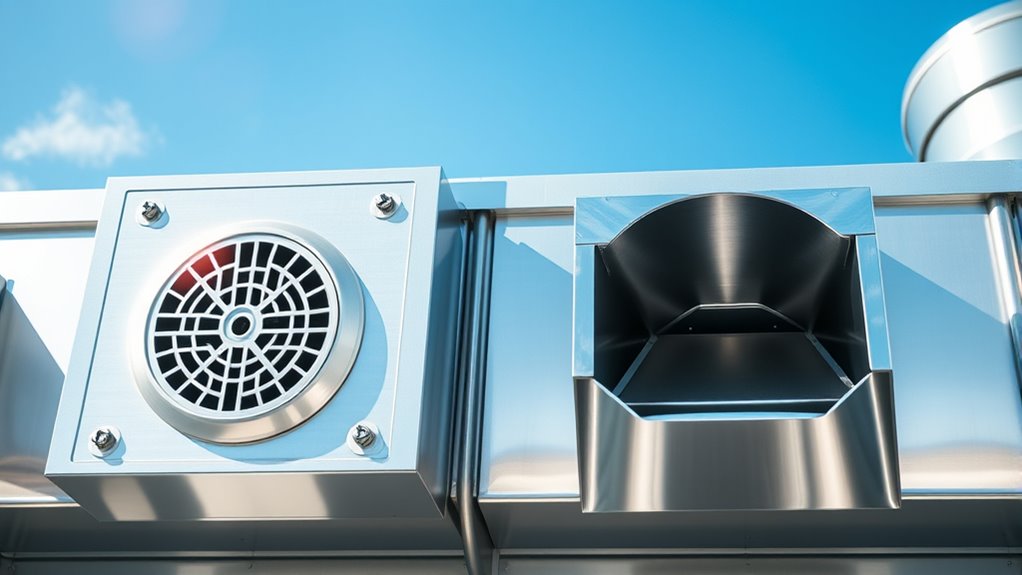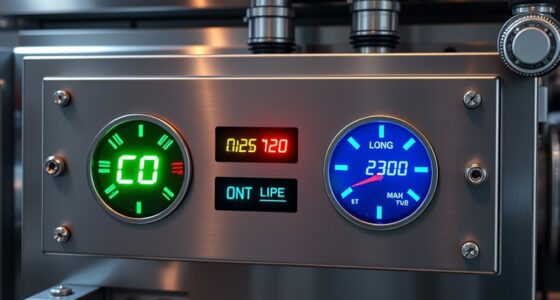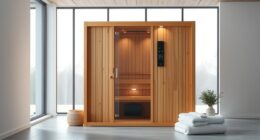To guarantee your ventilation system complies, you need to clearly differentiate fresh air intake from exhaust systems, following codes that specify their proper placement, airflow rates, and sealing. Properly installed systems prevent cross-contamination and maintain indoor air quality. Regular inspections, correct sealing, and adherence to standards like ASHRAE 62.1 are essential. Understanding these requirements helps you avoid costly rework and ensure safety—keep going to see how to make your system truly effective.
Key Takeaways
- Proper differentiation between fresh air intake and exhaust systems is essential for complying with building codes and ensuring indoor air quality.
- Codes specify the correct placement, sizing, and sealing of intake and exhaust vents to prevent cross-contamination and drafts.
- Regular inspections and maintenance verify that ventilation components meet regulatory standards and operate efficiently.
- Adhering to standards like ASHRAE 62.1 ensures minimum airflow rates and proper system design for compliance and safety.
- Utilizing AI-driven data analysis can optimize airflow balance, detect inefficiencies, and maintain ongoing compliance with ventilation codes.
Understanding Building Code Foundations for Ventilation
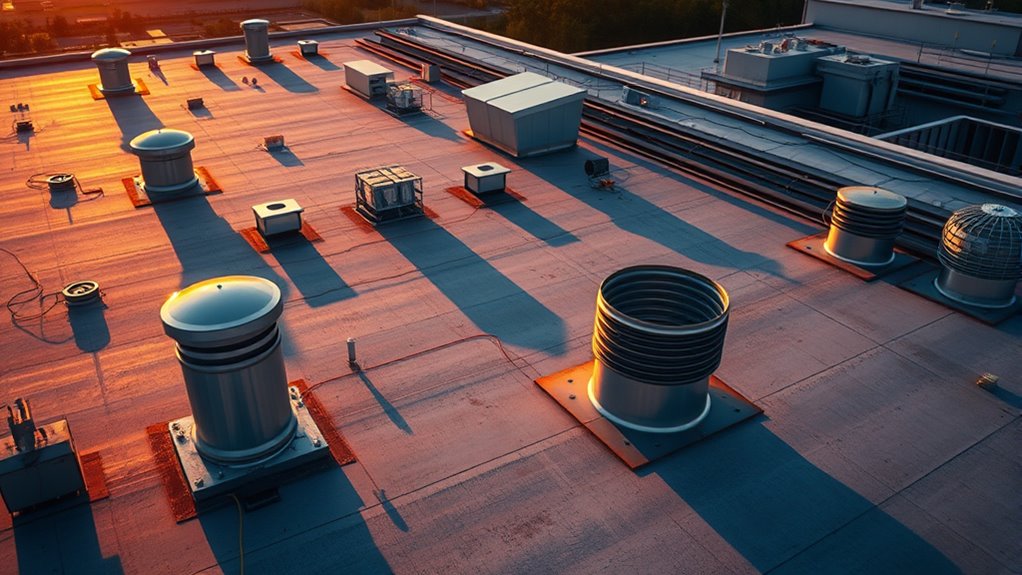
To guarantee proper ventilation, understanding the building code foundations is essential. Building codes set the minimum standards for maintaining good air quality through effective system design. They specify how ventilation systems should operate to ensure fresh air enters and stale air exits safely. These codes address aspects like airflow rates, duct sizing, and placement, helping you create a system that promotes healthy indoor environments. An understanding of ventilation system requirements is crucial for compliance and optimal performance. By adhering to these regulations, you prevent issues like poor air quality or moisture buildup. Knowing the code foundations helps you choose the right equipment and design a ventilation setup that complies with legal requirements. Ultimately, this ensures your project delivers reliable, efficient airflow and maintains a safe, comfortable space for occupants.
Differentiating Fresh Air Intake and Exhaust Systems

Understanding the distinct roles of fresh air intake and exhaust systems is vital for effective ventilation design. Your air intake system brings in outside air, providing fresh oxygen and maintaining indoor air quality. It’s imperative that this system is properly positioned to avoid contaminants and optimize airflow. In contrast, exhaust design focuses on removing stale air, humidity, and pollutants from indoor spaces. It guarantees proper air removal without creating negative pressure or unwanted drafts. Recognizing these differences helps you plan ventilation that balances fresh air supply with effective exhaust, preventing issues like backdrafts or poor air circulation. Properly differentiating between air intake and exhaust systems ensures your ventilation setup is efficient, compliant, and promotes healthier indoor environments. Incorporating ventilation techniques that align with these principles further enhances indoor air quality and system performance.
Key Compliance Standards and Regulatory Requirements
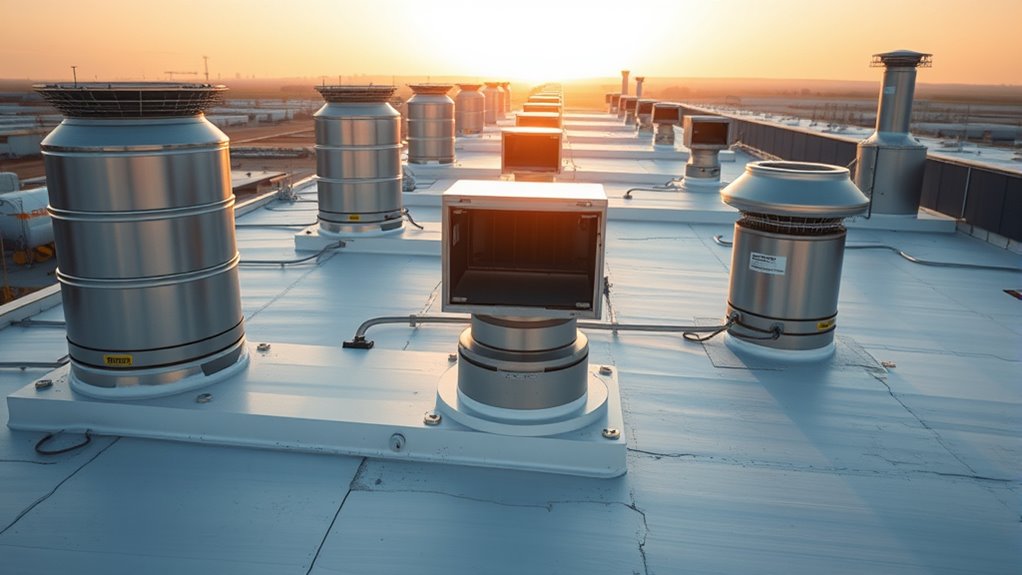
Effective ventilation systems must meet specific compliance standards and regulatory requirements to guarantee safety, efficiency, and indoor air quality. These standards ensure your system effectively manages air quality by controlling pollutants and maintaining proper airflow. Regulations like ASHRAE Standard 62.1 set minimum ventilation rates, promoting ideal ventilation efficiency. Building codes also specify exhaust and fresh air intake placements to prevent cross-contamination and ensure proper exhaust removal. Local ordinances may require additional measures, such as air filtration or monitoring devices. Staying compliant not only safeguards occupant health but also prevents costly penalties or system redesigns. By understanding and applying these key standards, you ensure your ventilation system performs reliably, maintains high air quality, and meets all legal requirements. Additionally, selecting appropriate ventilation components that meet industry standards is crucial for optimal system performance and longevity.
Practical Field Tips for System Installation and Maintenance
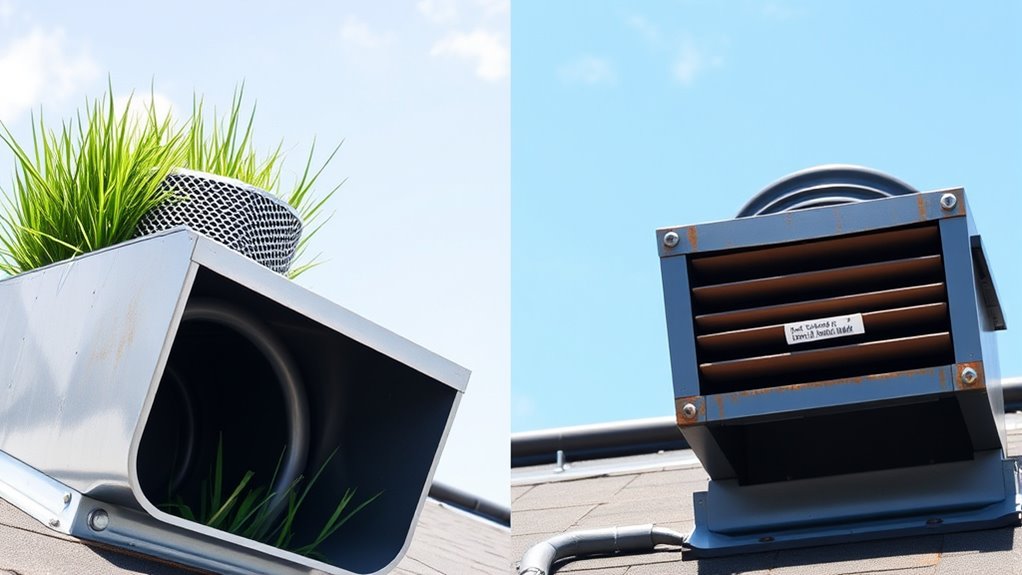
Proper installation and ongoing maintenance are essential to guarantee your ventilation system performs reliably and stays compliant. To optimize airflow, ensure intake and exhaust vents are correctly positioned, free of obstructions, and sealed properly. Regular maintenance scheduling helps identify issues early, such as blockages or wear, preventing airflow disruptions. Use durable filters and replace them according to manufacturer recommendations to maintain efficiency. When installing, double-check that all connections meet code requirements and that vents are properly vented outside. Keep detailed records of inspections and repairs to track system health. Prioritize airflow optimization during maintenance to prevent contamination and energy loss. Additionally, incorporating air quality management practices can significantly improve indoor environments. Consistent upkeep ensures your system remains effective, compliant, and capable of providing healthy indoor air quality over the long term.
Common Challenges and How to Address Them

You’ll face challenges like misinterpreting codes, which can lead to compliance issues. Site-specific conditions often complicate installation and maintenance, requiring tailored solutions. To stay compliant and effective, you need to understand these risks and implement clear strategies to address them. Additionally, understanding juice cleansing techniques can inform maintenance practices by promoting better health and operational efficiency in industrial environments.
Code Misinterpretation Risks
Have you ever misunderstood a code requirement that led to compliance issues or delays? Ventilation myths and code ambiguities often cause confusion, increasing the risk of misinterpretation. Misreading standards can lead you to install systems that don’t meet regulations, resulting in costly rework or fines. Sometimes, codes aren’t crystal clear, leaving room for different interpretations. To avoid these pitfalls, stay updated with the latest codes and seek clarification from authorities when in doubt. Collaborate with experienced consultants who understand the nuances. Document your interpretations and decisions to create a clear trail. Recognizing common ventilation myths and understanding the intent behind codes helps you make informed choices. Additionally, reviewing best practices in code compliance can significantly reduce errors and ensure your systems meet all requirements. By proactively addressing these risks, you ensure compliance while maintaining effective ventilation strategies.
Site-Specific Challenges
Site-specific challenges often complicate ventilation projects, requiring tailored solutions to meet both code requirements and practical constraints. Factors like building layout, existing infrastructure, and environmental conditions can impact air quality and system design. To address these challenges: 1. Assess the building’s airflow patterns to identify dead zones. 2. Customize intake and exhaust locations to avoid contamination sources. 3. Consider space limitations that restrict duct routing. 4. Use adaptable system components to accommodate future modifications. Additionally, implementing vertical storage solutions can optimize space, making it easier to install and access ventilation components in tight or complex layouts.
Ensuring Compliance Effectiveness
Ensuring that ventilation systems stay in compliance with codes and standards can be challenging, especially when site-specific conditions create unforeseen obstacles. To maintain compliance, focus on optimizing indoor air quality through effective air filtration and proper system design. Regular inspections help identify issues with indoor air and filtration efficiency before they become violations. You should also verify that exhaust and fresh air intake rates meet regulatory requirements, adjusting for occupancy and usage changes. Document all maintenance and calibration activities to demonstrate compliance efforts. Addressing common challenges like inadequate filtration or poorly balanced airflow ensures your system functions as intended. By proactively managing indoor air quality and adhering to standards, you ensure compliance remains effective and your ventilation system continues to protect occupant health. Additionally, understanding the impact of AI on data analysis can help improve the accuracy of airflow and filtration assessments over time.
Real-World Examples of Successful Ventilation Compliance
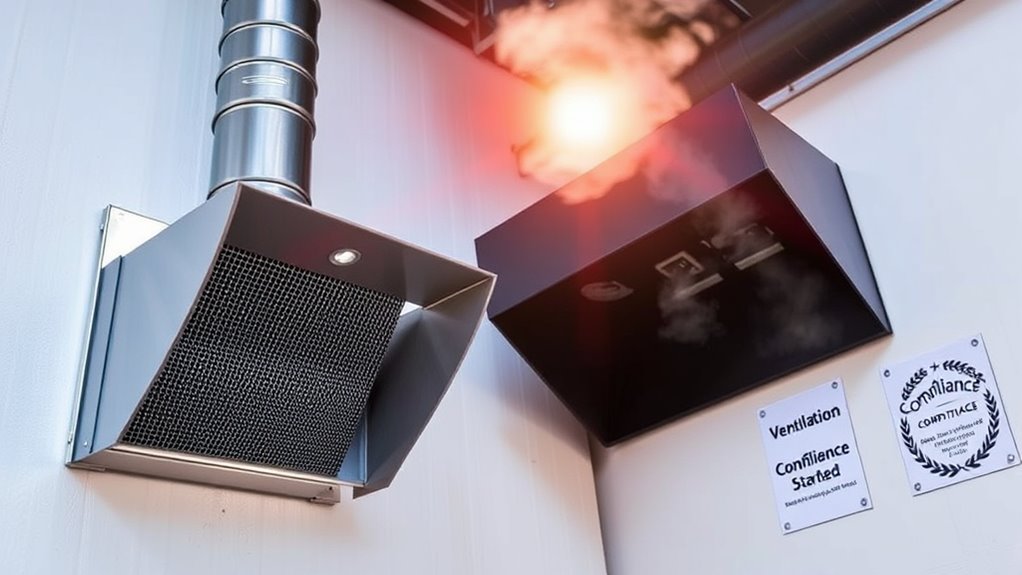
When ventilation systems meet compliance standards in real-world settings, the results can be impressive. Proper ventilation optimization and airflow balancing lead to healthier indoor environments and regulatory adherence. Here are examples of success:
- A commercial kitchen improved air quality by adjusting exhaust and fresh air intake, reducing odors and pollutants.
- An office building achieved energy efficiency through precise airflow balancing, cutting HVAC costs while maintaining standards.
- A manufacturing plant installed smart ventilation controls, ensuring consistent compliance during production fluctuations.
- A healthcare facility tailored ventilation strategies to meet specific infection control codes, enhancing patient safety.
- Embracing AI detection technologies can further optimize ventilation systems by analyzing airflow patterns and ensuring ongoing compliance with evolving standards.
These successes demonstrate that understanding and applying compliance principles lead to effective, sustainable ventilation solutions.
Frequently Asked Questions
How Do Local Climate Conditions Affect Ventilation Code Requirements?
Climate conditions directly influence your ventilation code requirements, as you must adjust to regional standards that consider the local climate. For example, in cold climates, you might prioritize exhaust systems to prevent moisture buildup, while in humid areas, fresh air intake needs careful regulation. Climate adaptation ensures your ventilation system works efficiently year-round, aligning with local codes to maintain indoor air quality and energy efficiency.
What Are the Cost Implications of Different Ventilation Compliance Strategies?
You should perform a thorough cost analysis to compare compliance costs of various ventilation strategies. Choosing advanced systems may involve higher upfront expenses but reduce long-term operational costs and improve indoor air quality. Simpler solutions might be less costly initially but could lead to increased maintenance and energy costs over time. Weighing these factors helps you select a strategy that balances initial investment with ongoing expenses, ensuring both compliance and cost-effectiveness.
How Can I Verify if My System Meets All Regulatory Standards?
You can verify your system meets all regulatory standards by checking the latest local codes and manufacturer specifications. Conduct routine inspections of your ventilation components to ensure proper operation and air quality. Use calibrated sensors to measure airflow and indoor air quality, ensuring system efficiency. Document maintenance and testing results to demonstrate compliance. Regularly consult with HVAC professionals who stay current on regulations to keep your system compliant and optimize air quality.
Are There Technological Innovations Improving Ventilation Code Adherence?
Yes, technological innovations like smart sensors and automation systems are improving ventilation code adherence. Smart sensors monitor air quality and airflow in real-time, alerting you to issues instantly. Automation systems adjust fresh air intake and exhaust based on occupancy and environmental conditions, ensuring compliance without manual intervention. These tools help you maintain ideal ventilation, meet regulatory standards, and enhance indoor air quality efficiently and reliably.
What Training Is Recommended for Maintaining Compliant Ventilation Systems?
You should undergo specialized training in ventilation standards and maintenance protocols. For example, a building manager who completed a certified HVAC course reduced system failures by 30%, guaranteeing code compliance. Focus on understanding airflow testing, filter replacement, and system calibration. Regularly updating your knowledge through workshops and manufacturer training helps you maintain compliance, prevent issues, and ensure peak indoor air quality. Stay proactive to keep your ventilation systems running smoothly and within standards.
Conclusion
So, after all this, it turns out following ventilation codes isn’t rocket science—just good sense and attention to detail. Ironically, the most overlooked part is often the simplest: proper intake and exhaust balance. But don’t worry, with a little effort and these tips, you’ll be breathing easy—and maybe even enjoying the irony that compliance can actually be this straightforward. Just remember, when in doubt, check your codes before your system does.
